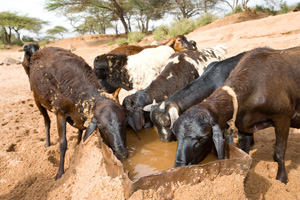
In northern Kenya, Caritas trucked in bales of hay for animals.
Credits: David Snyder/Caritas
By Laura Sheahen
“When you’re hungry, if you have seeds, you start cooking.” Kotola Susana grins ruefully as he describes the situation of many of his fellow Kenyan farmers. After years of poor rains culminated in a devastating drought in East Africa, farmers ran out of options. In southern Kenya, where they raise corn, sorghum and other grains, fields were dry and brown. In the north, where most families live off their herds, people watched goats and cows grow rib-thin and die.
The drought of 2011 destroyed agricultural and livestock safeguards that millions of East Africans rely on. “People ate up their seeds. The seed banking system had collapsed,” says Shadrack Musyoka, who works for Caritas in a southern farming area called Kitui. “And a lot of seed was wasted when people planted early and the rains didn’t come.
“People who were traditionally OK were suddenly not OK.”
In an area of northern Kenya called Marsabit, over 95% percent of people rely on their herds for all their income, and for food like milk and meat. Parents sell animals to pay for school; men give animals to their brides’ families as dowries. “In the West, people count what they have in terms of money. Here, it’s animals,” says Father Isaac Racho of the diocese of Marsabit. “It’s all the wealth they have.” To have 100 cows is not just a matter of pride, it’s also insurance against future problems.
Suddenly that nest egg was gone, as hundreds of thousands of animals began starving to death. “During the drought you’d see cattle shivering,” says Father Isaiah Ekalo, also of Marsabit. The cows were so thin they felt cold.
“I lost 90 goats,” says Zeinabu Eisimfecha, a widow raising seven young children in Marsabit. “When my animals die, I feel pain in my heart.” Westerners who have watched their retirement funds dwindle in the market can empathize. Animals are a person’s job, their children’s education, their pension, and their children’s wedding fund all rolled into one.
“The animals kept dying,” Zeinabu continues. “Or they were so thin that farmers couldn’t sell them.” By autumn 2011, the bones of cattle, goats, buffalo and even elephants littered the dry plains of East Africa.
Caritas brought in emergency food rations and drinking water, but also focused on saving the potential of people’s farms and herds before it was too late. In northern Kenya, Caritas trucked in bales of hay for animals. In Ethiopia, it bought animals at fair prices to give meat to hungry families, and restocked herds with healthy animals once more fodder and water was available. In southern Kenya, Caritas gave farmers seeds that would mature quickly, so they would get a harvest from the rains of late autumn 2011 even if they were brief. Throughout east Africa, Caritas water projects provided separate drinking water areas for animals and irrigation canals for fields.
“Caritas trained us on how to keep our farms going, which is our only source of food for our families and only source of income,” says a young father named Mwinzi Munyoki Tutu. The Caritas project in his farming village taught him about soil and water conservation techniques. It also mobilized neighbours to plough, weed and hoe each others’ fields together. “We’ve learned from the Caritas project that we should be generous to each other,” he says.
In many communities, Caritas pays villagers to make crop terraces that will retain water rather than let it flow away. “The group made terraces in my farm,” says Nancy Wanjagi, a mother of two. “By myself I couldn’t have done it.”
“We used to have some irrigation canals, but not everywhere,” says Mwinzi Munovei, a grandfather of seven. “After Caritas came, we learned the importance of having canals everywhere.” His wife is particularly grateful for the seeds Caritas gave them.
“Rain has become highly unreliable,” says Caritas’ Musyoka. “It’s not possible to expect a good harvest with seeds that require a lot of water.” That’s why Caritas worked with seed vendors to find seeds that would yield harvests after even brief rains.
“The Caritas seed support is special because the seeds are drought-tolerant,” says Nyaga Ngata, who is raising five of her grandchildren after their parents died of AIDS. When it finally began to rain in October 2011, Nyaga planted the fast-growing seeds quickly. A month later, “we’re already eating the cowpea leaves,” she says.
The hay has saved herdsmen in the north from losing their livelihood, and the seeds have helped farmers in the south bounce back more quickly from the drought. Zeinabu saved some of her goats, to her joy: “Please take our gratitude back to the people who gave.”
Lois, one of a group of women tilling a neighbour’s field, echoes this. “We’re grateful that they sacrificed for us.” She smiles broadly. “Please tell the people in other countries, when we harvest, they should come here and have some food.”
